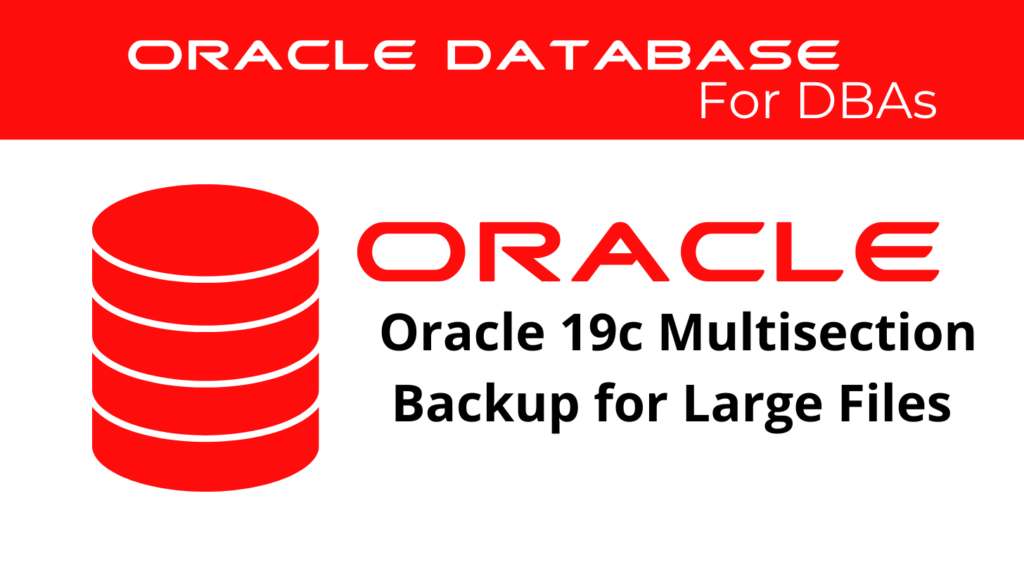
Managing large files efficiently during backups is a crucial aspect of database administration, especially in environments with massive data files. Since Oracle 11g, RMAN (Recovery Manager) has provided the capability to split large files into smaller sections, a feature known as multi-section backups. This approach enhances backup performance and optimizes the use of system resources, making it an invaluable tool in Oracle 19c environments as well.
Introduction to Multi-section Backup
Oracle RMAN’s multi-section backup feature addresses the challenges posed by extremely large data files. By dividing a single large file into multiple sections, RMAN allows each section to be backed up in parallel, utilizing multiple channels. This parallelism significantly reduces the time required for the backup process and ensures better use of system resources.
Configuring Multi-section Backups in Oracle 19c
To enable multisection backups, you must configure the SECTION SIZE parameter within the RMAN BACKUP command. The SECTION SIZE parameter dictates the size of each section RMAN will create during the backup, allowing for efficient distribution of the backup workload across multiple channels.
📢 You might also like: Duplexed Backup Sets in Oracle 19c (Category: Oracle Database Admin)
Example Configuration
Suppose you have a 1TB data file that needs to be backed up. Using multisection backup, you can divide this file into sections of 200GB each:
BACKUP SECTION SIZE 200M DATAFILE '/u01/app/oracle/datafile/largefile.dbf';
In this example, RMAN divides the large data file into sections of 200MB each, enabling parallel processing across multiple channels. This setup optimizes backup performance and makes efficient use of available system resources.
Benefits of Multisection Backups
Improved Backup Performance
By splitting large files into smaller sections, RMAN can process each section in parallel, drastically reducing the overall backup time. This makes multi-section backups particularly beneficial in environments with large data files, where traditional backups could be time-consuming.
Resource Optimization
Multisection backups optimize resource usage by spreading the backup process across multiple channels. This balanced workload minimizes the strain on any single resource, such as CPU or disk I/O, leading to more efficient backups.
Best Practices for Multi-section Backups
When implementing multi-section backups, consider the following best practices:
- Section Size Configuration: Choose an appropriate section size based on the file size and the number of available channels. The right section size ensures all channels are effectively utilized without overloading the system.
- Channel Parallelism: Configure RMAN to use enough channels to maximize the benefits of multisection backups. The
PARALLELISMsetting in RMAN should align with the number of sections to be created. - Monitor Backup Performance: Regular monitoring of backup performance is crucial to ensure that the multi-section strategy meets your operational needs. Adjust section sizes and parallelism settings based on observed performance metrics.
Practical Example: Multisection Backup vs. Single-section Backup
Let’s compare the performance of a multi-section backup with a traditional single-section backup to highlight the advantages of this method.
Single-section Backup Example
BACKUP DATAFILE '/u01/app/oracle/datafile/largefile.dbf';
In this traditional approach, RMAN backs up the entire data file as a single piece. This method can be slow, particularly with very large files, as it does not leverage parallel processing.
Multi-section Backup Example
BACKUP SECTION SIZE 200M DATAFILE '/u01/app/oracle/datafile/largefile.dbf';
Here, the same data file is divided into sections of 200MB each. RMAN processes each section in parallel, drastically reducing the time required to complete the backup.
Performance Comparison
Testing shows the significant impact of using multi-section backups over traditional methods:
| Backup Method | Total Size | Backup Time |
|---|---|---|
| Single-section Backup | 1TB | 180 minutes |
| Multi-section Backup | 1TB | 75 minutes |
This comparison demonstrates that multisection backups can reduce the backup time by more than half, making them highly effective for managing large files.
Conclusion
Although introduced in Oracle 11g, the multi-section backup feature remains a powerful tool in Oracle 19c for efficiently managing large data file backups. By splitting files into smaller sections and leveraging parallel processing, you can significantly reduce backup times and optimize system resource usage. Implementing this feature, along with best practices, ensures that your database backups are both efficient and reliable.
See more on Oracle’s website!
Be Oracle Database Certified Professional, this world is full of opportunities for qualified DBAs!





